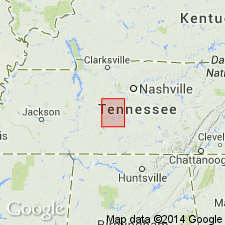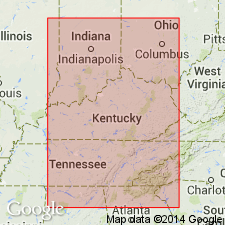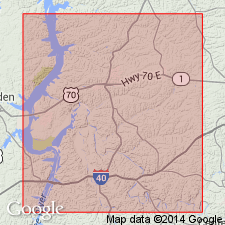
- Usage in publication:
-
- Fernvale formation*
- Modifications:
-
- Named
- Dominant lithology:
-
- Shale
- Limestone
- AAPG geologic province:
-
- Cincinnati arch
Summary:
Named the Fernvale formation for Fernvale, Williamson Co., western TN. Also recognized in northern AR, southeastern MO, and southwestern IL. Consists of soft green and chocolate shales with one or more layers of coarsely crystalline, occasionally flesh-colored limestone that contains greenish specks; lower part of units is sometimes conglomeratic and highly phosphatic. In some areas, base of formation is composed of 5 to 6 feet of strongly ferruginous, vermilion-red limestone. Thickness ranges from 0 to 40 feet. Unconformably overlies the Leipers formation and unconformably underlies the Clifton limestone. The Fernvale is of Late Ordovician age.
Source: GNU records (USGS DDS-6; Reston GNULEX).

- Usage in publication:
-
- Fernvale Limestone*
- Modifications:
-
- Overview
- AAPG geologic province:
-
- Cincinnati arch
Summary:
The Fernvale Limestone in central TN consists of gray, coarsely crystalline, massive or irregularly bedded limestone. In some places, unit contains thin, wavy, lenticular beds and may be ferruginous or phosphatic. Unconformably overlies the Leipers or Arnheim Formations and conformably underlies the Sequatchie Formation. The dominant fauna are brachiopods, particularly RHYNCHOTREMA CAPAX. The Fernvale is of Late Ordovician (early Richmondian) age.
Source: GNU records (USGS DDS-6; Reston GNULEX).

- Usage in publication:
-
- Fernvale Formation*
- Modifications:
-
- Age modified
- Biostratigraphic dating
- AAPG geologic province:
-
- Cincinnati arch
Summary:
Presence of AMORPHOGNATHUS ORDOVICICUS at 843.6 to 844.5 ft in du Pont Geohydrological Survey Well, near Waverly, Humphreys Co., central TN, restricts age of upper part of Fernvale Formation to ORDOVICICUS Zone (Maysvillian through Gamachian, or Ashgillian) of the Late Ordovician (Sweet and Bergstrom, 1986).
Source: GNU records (USGS DDS-6; Reston GNULEX).
For more information, please contact Nancy Stamm, Geologic Names Committee Secretary.
Asterisk (*) indicates published by U.S. Geological Survey authors.
"No current usage" (†) implies that a name has been abandoned or has fallen into disuse. Former usage and, if known, replacement name given in parentheses ( ).
Slash (/) indicates name conflicts with nomenclatural guidelines (CSN, 1933; ACSN, 1961, 1970; NACSN, 1983, 2005, 2021). May be explained within brackets ([ ]).

